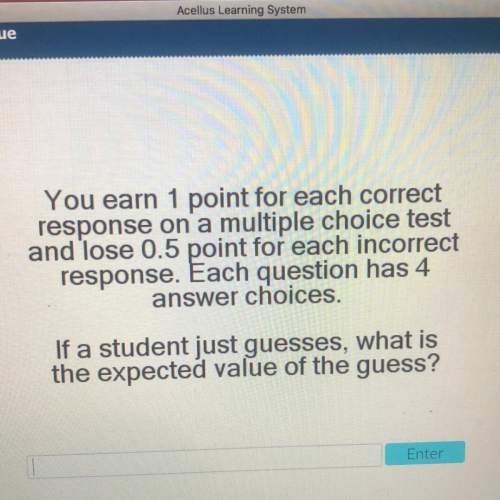
Mathematics, 08.12.2020 01:00 JellalFernandes
Sahil watched a demonstration in which a scientist combined two substances in a sealed container and analyzed the results. The ending substances did not look the same as the starting substances. Sahil was given a diagram with the repeating groups of atoms that make up the starting substances, plus information about the properties of the starting and ending substances. He created a model of the repeating groups of atoms that might make up the two ending substances. Does his model correctly show why the properties of the ending substances are different from the properties of the starting substances? Describe what could be correct or incorrect about his model. Captionless Image

Answers: 2


Another question on Mathematics

Mathematics, 21.06.2019 15:10
6x - 8 = 16 solve the following equation. then place the correct number in the box provided.
Answers: 2

Mathematics, 21.06.2019 17:00
Me on this one i will give you 20pts. answer should be in detail . this is the discussion topic. one of the most fiercely debated topics in sports is the hot hand theory. the hot hand theory says that success breeds success. in other words, rather than each shot a basketball player takes or each at-bat a baseball player has being an independent event, the outcome of one event affects the next event. that is, a player can get hot and make a lot of shots in a row or get a lot of hits in a row. the hot hand theory, however, has been shown to be false in numerous academic studies. read this article, which discusses the hot hand theory as it relates to a professional basketball player. state whether you agree or disagree with the hot hand theory, and give reasons for your opinion. be sure to use some of the terms you’ve learned in this unit, such as independent event, dependent event, and conditional probability, in your answer.
Answers: 2

Mathematics, 21.06.2019 21:30
In a test for esp (extrasensory perception), the experimenter looks at cards that are hidden from the subject. each card contains either a star, a circle, a wave, a cross or a square.(five shapes) as the experimenter looks at each of 20 cards in turn, the subject names the shape on the card. when the esp study described above discovers a subject whose performance appears to be better than guessing, the study continues at greater length. the experimenter looks at many cards bearing one of five shapes (star, square, circle, wave, and cross) in an order determined by random numbers. the subject cannot see the experimenter as he looks at each card in turn, in order to avoid any possible nonverbal clues. the answers of a subject who does not have esp should be independent observations, each with probability 1/5 of success. we record 1000 attempts. which of the following assumptions must be met in order to solve this problem? it's reasonable to assume normality 0.8(1000), 0.2(1000)%30 approximately normal 0.8(1000), 0.2(1000)% 10 approximately normal srs it is reasonable to assume the total number of cards is over 10,000 it is reasonable to assume the total number of cards is over 1000
Answers: 1

Mathematics, 22.06.2019 00:00
Need plz been trying to do it for a long time and still haven’t succeeded
Answers: 1
You know the right answer?
Sahil watched a demonstration in which a scientist combined two substances in a sealed container and...
Questions


Mathematics, 08.12.2020 22:20

Mathematics, 08.12.2020 22:20





Biology, 08.12.2020 22:20

Social Studies, 08.12.2020 22:20

Mathematics, 08.12.2020 22:20






Health, 08.12.2020 22:20



Mathematics, 08.12.2020 22:20

German, 08.12.2020 22:20




